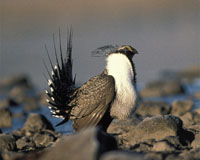| . |  |
. |
Calgary, Canada (SPX) Nov 29, 2010 Researchers demonstrate that the extinction of dinosaurs 65 million years ago made way for mammals to get bigger - about a thousand times bigger than they had been. The study, which is published in the prestigious journal Science, is the first to show this new pattern of increased body size of mammals after the exit of the dinosaurs. "Basically, the dinosaurs disappear and all of a sudden there is nobody else eating the vegetation. That's an open food source and mammals start going for it, and it's more efficient to be an herbivore when you're big," says paper co-author Dr. Jessica Theodor, associate professor in the Department of Biological Sciences at the University of Calgary. Theodor says as well as confirming the dramatic growth in mammalian size after the dinosaurs, the study shows that the ecosystem is able to reset itself relatively quickly. "You lose dinosaurs 65 million years ago, and within 25 million years the system is reset to a new maximum for the animals that are there in terms of body size. That's actually a pretty short time frame, geologically speaking," she says. "That's really rapid evolution." Theodor says mammals grew from a maximum of about 10 kilograms when they were sharing the earth with dinosaurs to a maximum of 17 tonnes afterwards. "Nobody has ever demonstrated that this pattern is really there. People have talked about it but nobody has ever gone back and done the math," says Theodor one of the 20 researchers from around the world who worked on the study. "We went through every time period and said OK, for this group of mammals what's the biggest one? And then we estimated its body mass." In order to document how big mammals grew after the 'competitive release' caused by the extinction of dinosaurs, researchers collected data on the maximum size for major groups of land mammals on each continent, including Perissodactyla, odd-toed ungulates such as horses and rhinos; Proboscidea, which includes elephants, mammoth and mastodon; Xenarthra, the anteaters, tree sloths, and armadillos; as well as a number of other extinct groups. The results give clues as to what sets the limits on mammal size on land; the amount of space available to each animal and the climate they live in. The colder the climate, the bigger the mammals seem to get, as bigger animals conserve heat better. It also shows that no one group of mammals dominates the largest size class - the absolute largest mammal belongs to different groups over time and space.
Share This Article With Planet Earth
Related Links University of Calgary Darwin Today At TerraDaily.com
 Sage-Grouse Western Habitat Map Completed
Sage-Grouse Western Habitat Map CompletedWashington DC (SPX) Nov 29, 2010 Secretary of the Interior Ken Salazar has announced the completion of a breeding bird density map for the greater sage-grouse by the Bureau of Land Management in coordination with the Western Association of Fish and Wildlife Agencies, the U.S. Fish and Wildlife Service, and the Natural Resources Conservation Service. The map identifies important range-wide focal areas having high density o ... read more |
|
| The content herein, unless otherwise known to be public domain, are Copyright 1995-2010 - SpaceDaily. AFP and UPI Wire Stories are copyright Agence France-Presse and United Press International. ESA Portal Reports are copyright European Space Agency. All NASA sourced material is public domain. Additional copyrights may apply in whole or part to other bona fide parties. Advertising does not imply endorsement,agreement or approval of any opinions, statements or information provided by SpaceDaily on any Web page published or hosted by SpaceDaily. Privacy Statement |